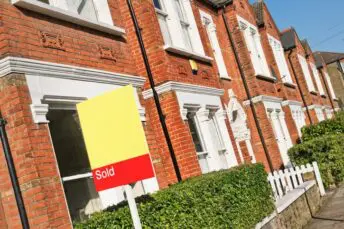House Price Watch Feb 2023
Transactions, monthly house prices and the annual rate of house price growth fell in February. Homes are taking longer to sell and, given this, sellers are pricing homes realistically. Average house prices are still high -- above where they were at the start of 2022. As a result, housing affordability will continue to feel challenging for many buyers. There are encouraging signs that mortgage rates are stabilising around 4% but with stretched affordability activity is likely to remain subdued until real incomes begin to rise and the economic outlook becomes more certain.
What’s happening nationally
House prices are down on average -0.2% in the past month and annual house price growth has slowed to +2.4%.
The indices are showing a range of house price movements over the past month. Most are showing a slight drop or stable house prices, while Halifax, saw house prices increase in February.
Indices based on:
Land Registry – registered property transactions in January.
Nationwide & Halifax – mortgage valuations in February.
Rightmove – asking prices posted on Rightmove in February.
*Rightmove is not included in the index average as the basis for its index is different (asking price vs agreed sale price)
| Index reports: | Monthly change | Annual change |
|---|---|---|
| Land registry | -1.1% | +6.3% |
| Nationwide | -0.5% | -1.1% |
| Halifax | 1.1% | +2.1% |
| Rightmove | +0% | +3.9% |
| Average change | -0.2% | +2.4% |
House prices in your area
House prices are up in few areas and down in most others this month.
On the up: North East (+0.6%), West Midlands (+0.2%)
Down: Wales (-2.3%), Scotland (-0.5%), Northern Ireland (-0.5%), Yorkshire & Humber (-2.5%), North West (-2.4%), East Midlands (-1.7%), South East (-1.2%), East of England (-1.1%), London (-1.0%), South West (-0.4%)
Average house prices are highest in London (£534K) and lowest in the North East (£163K).
House price growth varies by property type. Detached (+6.8%), semi detached (7.5%) and terraced (7.0%) homes have seen the biggest rise and flats/ maisonettes the smallest (+2.3%) according to January Land Registry data.
| UK Region | Average price £ | Monthly change | Annual change |
|---|---|---|---|
| England | |||
| Nothern Ireland | |||
| Scotland | |||
| Wales | |||
| North West | |||
| Yorkshire and The Humber | |||
| North East | |||
| West Midlands | |||
| East Midlands | |||
| South West | |||
| East of England | |||
| South East | |||
| London |
| UK City | Average price | Annual change |
|---|---|---|
Market Monitor
There were 90K transactions in February, 4% lower than January and 18% lower than February last year. 90K transactions is below the usual level for this time of year based on recent years.
Demand continues to fall but at a slower rate than in recent months. New instructions are relatively stable month on month but are lower than they were last February. Average level of stock per agent falls.
Time to sell increases by 10 days in the last month.
How busy is the market?
- Not busy
- Normal
- Very busy
- Transactions down in February, below typical transactions for this time of year
- Total transactions in February 900K
- -4% from last month
- -18% from February last year
Homes for sale vs homebuyers
- Good availability of homes
- Normal
- Shortage of homes
- Buyer enquiries continue to fall but at a slower rate(-29% RICS); tenth monthly drop
- Seller enquiries down (-4% RICS)
- Average stock per agent 42; down from 43 last month (incl under offer/ Sold STC Rightmove)
Average speed of sale
- Fast
- Normal
- Slow
- 62 days to find a buyer up from 52 days (12 month average 39 days Rightmove)
What the experts say
Rightmove - agent's view

“The big question this month was whether we would see new sellers increasing their asking prices as has been the yearly norm as we approach the spring selling season. This month’s flat average asking price indicates that many sellers are breaking with tradition and showing unseasonal initial pricing restraint. In addition to market conditions demanding greater realism on price, we are transitioning into a slower paced market, where buyers will take longer to find the right property at the right price due to the higher cost of servicing a mortgage. There are other indicators that this will be a softer rather than a hard transition despite the turbulence at the end of 2022. Homeowners who are coming to market in the upcoming spring season should use their agent’s expertise and get the price right the first time, which can really help to find the right buyer more quickly.”
Nationwide

“Annual house price growth slipped into negative territory for the first time since June 2020. This likely reflects the lingering impact on confidence as well as the cumulative impact of financial pressures that have been weighing on households for some time. Indeed, inflation has continued to outpace wage growth and mortgage rates remain significantly higher than the lows of 2021. Even though consumer sentiment has improved in recent months, it is still languishing at levels prevailing during the depths of the financial crisis. It will be hard for the market to regain much momentum in the near term since economic headwinds look set to remain relatively strong. Indeed, despite the modest fall in house prices, for a prospective first-time buyer earning the average income looking to buy the typical home, mortgage payments remain well above the long run average as a share of take-home pay. In addition, deposit requirements remain prohibitively high for many and saving for a deposit remains a struggle given the rising cost of living, especially for those in the private rented sector, where rents have been rising strongly.”
Halifax

“When comparing to January, there was a 1.1% increase in house prices through the month of February, although overall prices are flat compared to three months ago. Recent reductions in mortgage rates, improving consumer confidence, and a continuing resilience in the labour market are arguably helping to stabilise prices following the falls seen in November and December. Still, the underlying underlying activity continues to indicate a general downward trend. In cash terms, house prices are down around £8,500 (-2.9%) on the August 2022 peak but remain almost £9,000 above the average prices seen at the start of 2022 and are still above pre-pandemic levels, meaning most sellers will retain price gains made during the pandemic. With average house prices remaining high, housing affordability will continue to feel challenging for many buyers.”
Zoopla (Hometrack)

“The transition to a buyers’ market is being accompanied by nationwide repricing as the market adjusts to the reduction in buying power resulting from higher mortgage rates. Buying power is starting to recover as mortgage rates fall from their 6% highs of late 2022. Even at 4% mortgage rates, the average home buyer has 20% less buying power than they did a year ago when mortgage rates were 2%. This will not feed straight through into house prices. Some buyers will look to buy smaller or cheaper homes. Others may inject more equity into purchases or be in position to spend more on mortgage repayments. The housing market is adjusting to higher mortgage rates better than many had feared. Our view has always been that 4% mortgage rates are manageable and consistent with very low levels of house price growth or price falls in real terms. It is welcome to see evidence of greater realism from sellers on pricing to secure a sale. All this points to reasonable levels of turnover in 2023.”
RICS

“The results of the February 2023 RICS UK Residential Survey remain generally downbeat although there are a couple of closely-watched indicators consistent with a more stable picture emerging through the course of 2023. This slightly more reassuring prospect is also evident in some of the remarks from contributors.”




